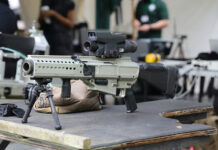The U.S. Army’s Future Combat System (FCS) program comprises 14 integrated weapon systems and an advanced information network. The $160 billion program is the centerpiece of the Army’s effort to transition to a lighter, more agile, and more capable combat force. The program led by Lead Integrators Boeing and SAIC, represent a generation leap in technology, procurement and scale for the army, research and development community and defense industry. The scale of the program, the Army’s acquisition strategy and the cost involved, led to establishment of special oversight and review by the U.S. Government Accountability Office (GAO), required to report annually on the program’s progress.
Despite the progress made with the program in recent months, GAO assessed “”The progress made during the year by the FCS program, in terms of knowledge gained, is commensurate with a program in early development. Yet, the knowledge demonstrated thus far is well short of a program halfway through its development schedule and its budget”. The report indicated that delayed development progress could lead to increased costs and delays, as the program enters the most expensive and problematic phase of full scale development. “FCS’s demonstrated performance, as well as the reasonableness of its remaining resources, which will be paramount, at the 2009 milestone review for the FCS program.,GAO determines. The report warns that requirements definition and preliminary designs are proceeding but are not yet complete in several of the program’s key areas. “Critical technologies are immature; complementary programs are not yet synchronized; and the remaining acquisition strategy is very ambitious.” GAO continued.
GAO warns that the program is entering a critical path in 2008, as the Army decides to commit on early production of several FCS-related systems (called Spinout I), in advance of the low-rate production decision for the FCS core program in 2013. However, the Army’s commitment to the first spin out may be made before testing is complete. This decision was made in order to field some systems wit the current force, rather than the future FCS brigades, as those systems were determined as offering functions and services urgently required by warfighters today. GAO warned that production commitments should be planned after key information on all related systems is available. The Army intends to commit to production of early versions of the Non-Line-of-Sight Cannon this year. This commitment is being made to respond to congressional direction to field the cannon.
GAO warns that the cost of the program, currently set at $160 billion could prove underestimated. Two independent cost assessments made recently are significantly higher than the Army’s estimate. While the Army reduced the content of the program from 18 systems to 14, and plans to further reduce the number of platforms if further cost control measures fail, GAO indicated that if those higher cost estimates prove correct, it seems unlikely that the Army could reduce FCS content enough to stay within the current ceiling while still delivering a capability that meets requirements. The GAO report recommended that clear criteria will be set for the program in time for the 2009 ‘go/no go’ decision; The report also recommends that the viable alternatives to FCS should be considered prior to that decision.



















